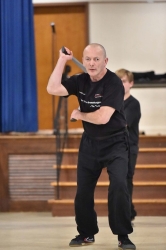
Although known primarily as a blade/weapon art Dekiti Tirsia has numerous empty-hand techniques that it can call upon in an instant for use in self-defense situations. The Philippines is located right at the juxtaposition of many Asian/Southeast Asian countries that each have a unique martial art. There has always been a tremendous amount of cross-learning in this area. Peaceful or combative, thoughts on martial arts were shared and compared. Jesse Enkamp did a video recently on how the Filippino arts influenced the arts of Okinawa,(the birthplace of karate). The Moros of Southern Philippines brought with them their Silat from Indonesia. The Chinese have traded or pirated in the Philippines forever,(Kuntau can be translated to Kung Fu). It is all these interactions that have made Filippino martial arts and in my eyes, particularly Dekiti Tirsia Siradas So Devastating.
The Hands
Most of the hand strikes of Dekiti Tirsia are done open-handed, mostly as a halo strike. The practitioner must be very cognizant of the disposition of his own weapon as well as the weapon(s) of his opponent. We do a “palm strike in Dekiti Tirsia, typically the fingers are not held tightly together. Now no matter what style of martial arts you do you may think that this is not a wise idea. That is why Dekiti practitioners must have extensive training and be very cognizant of what they are doing. Having knowledge of what limb you are not using is as important as the knowledge of the limb you are using.
Striking ripping and grabbing are some of the “palm” strikes used as well as poking and gouging. Knife or blade hand strikes are also extensively used in offensive situations as well as defensive, always remember, 45*/135* bend in the arm. Elbows are brought into play at close range utilizing the same concepts of 12 angles of attack. A clenched fist is of course utilized as it could also be used when holding a weapon.
The Feet
The kicks found in Dekiti Tirsia are the same kicks you would expect in any style. All the basics are front, side, back, round, hook, and all the “traditional” kicks, the biggest difference being in the presentation. Being aware of your surroundings and the weaponry of your opponent is essential in Kali. If your opponent is armed with a blade that could make high kicks very dangerous, we always want to assume that our opponent knows as much about vital points as we do. Ground kicks are introduced in the event a fight ends up on the ground,(there is much jungle on Negros Island as well as all the Islands in the Philippines).
Locks
There are 12 primary Locks of Dekiti Tirsia along with the defenses against them. Knowledge of all 12 plus the many variations is essential for instantaneous reaction. Striking is all important here, always strike first, never reach for a lock, and if one appears take it. A great deal of sensitivity is needed to come into play here, and that is only achieved through constant training.
Throws
You will find takedowns and throws everywhere in Dekiti Tirsia. Weapon-to-weapon or empty hand versus weapon takedowns are used almost instinctively. However, once you enter the world of empty-hand defenses in Dekiti Tirsia the takedown and finish are everything. An opponent still standing is still an opponent.
Engage
Once we engage with an opponent our motions must become instinctual. If we have some preconceived notion of exactly what the outcome will be, then we have set ourselves up to lose. Combat is as fluid as a dance and as meticulous as a chess game. In a chess game, a good player will plan 5 moves ahead for all outcomes. A master chess player will plan 15 moves ahead. That is why the Dekiti Tirsia arsenal is designed the way it is. You learn all the tools and have them at your disposal for when you have to make that 15th move.
- The Martial Effectiveness of Drills in Filipino Martial Arts (FMA) - February 5, 2025
- The Resurgence of Traditional Martial Arts in Modern Mixed Martial Arts - January 7, 2025
- The Night Christmas Almost Died - December 21, 2024

Leave a Reply